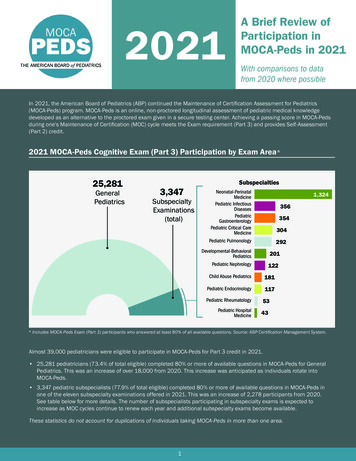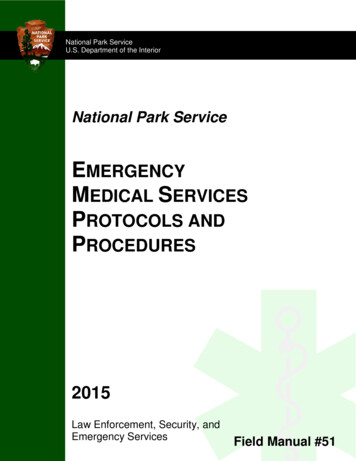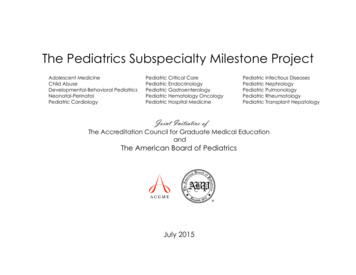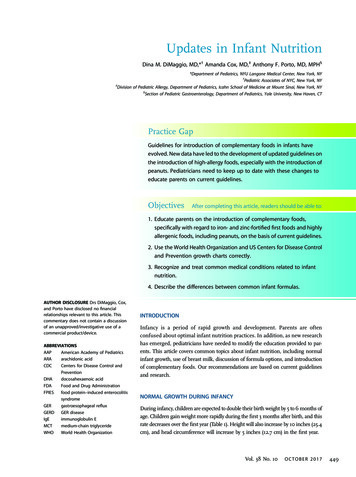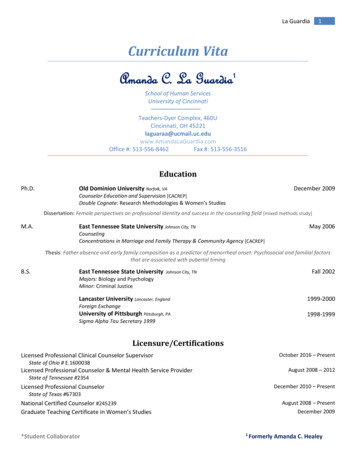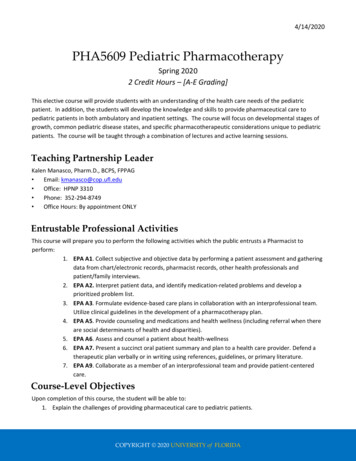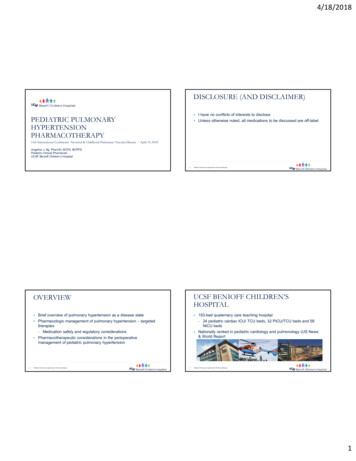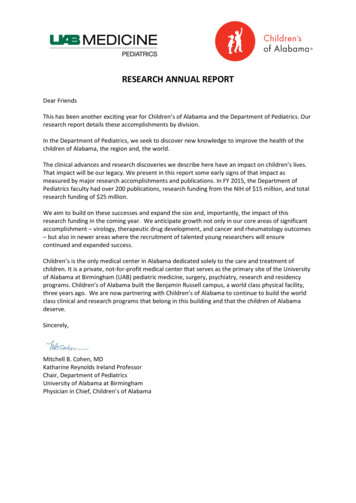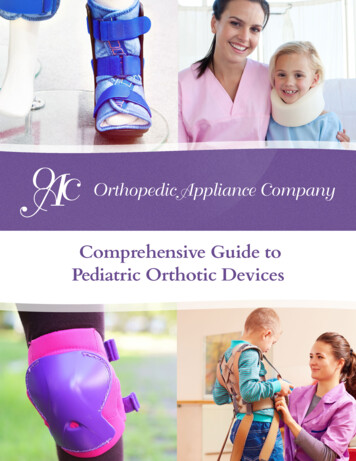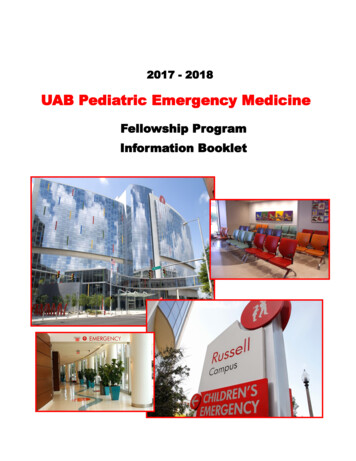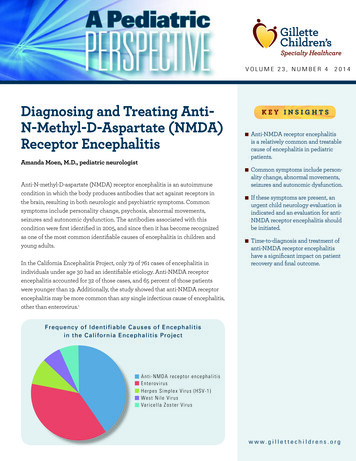
Transcription
VOLUME 23, NUMBER 4Diagnosing and Treating AntiN-Methyl-D-Aspartate (NMDA)Receptor EncephalitisKEY INSIGHTS Amanda Moen, M.D., pediatric neurologist Anti-N-methyl-D-aspartate (NMDA) receptor encephalitis is an autoimmunecondition in which the body produces antibodies that act against receptors inthe brain, resulting in both neurologic and psychiatric symptoms. Commonsymptoms include personality change, psychosis, abnormal movements,seizures and autonomic dysfunction. The antibodies associated with thiscondition were first identified in 2005, and since then it has become recognizedas one of the most common identifiable causes of encephalitis in children andyoung adults.In the California Encephalitis Project, only 79 of 761 cases of encephalitis inindividuals under age 30 had an identifiable etiology. Anti-NMDA receptorencephalitis accounted for 32 of those cases, and 65 percent of those patientswere younger than 19. Additionally, the study showed that anti-NMDA receptorencephalitis may be more common than any single infectious cause of encephalitis,other than enterovirus.12014 Anti-NMDA receptor encephalitisis a relatively common and treatablecause of encephalitis in pediatricpatients.Common symptoms include personality change, abnormal movements,seizures and autonomic dysfunction.If these symptoms are present, anurgent child neurology evaluation isindicated and an evaluation for antiNMDA receptor encephalitis shouldbe initiated.Time-to-diagnosis and treatment ofanti-NMDA receptor encephalitishave a significant impact on patientrecovery and final outcome.Frequency of Identifiable Causes of Encephalitisin the California Encephalitis ProjectA nti -NMDA re c e p to r e n c e p h a l i ti sEn te ro v i ru sH erp e s Si m p l e x Vi ru s ( HSV-1 )We s t Ni l e Vi ru sVari c e l l a Z o s te r Vi ru sw w w. g i l l e t t e c h i l d r e n s . o r g
Clinical PresentationPatients with anti-NMDA receptor encephalitis have a constellation of symptoms that are recognizable to providers familiarwith the condition. However, comparisons of presentationsamong patients with this condition show significant variability.Most patients will exhibit multiple, but not all, possible symptomsof the condition. The order in which symptoms develop can varyfrom patient to patient, and not all symptoms may be presentduring the initial evaluation. Additionally, presentation variesby age group. Very young children present with symptoms thatare distinct from those seen in teens and adults.Psychiatric Symptoms The most common presenting symptoms in teenagers andadults include anxiety, insomnia, delusions, mania and paranoia. Young children tend to present with behavior changes, tempertantrums, hyperactivity and irritability, instead of overtpsychotic symptoms. This initial phase is often followed by a stage with periods ofalternating agitation and catatonia. Often the first provider to see the patient is a psychologistor psychiatrist.Language Changes A reduction in spontaneous speech occurs in all age groupsand may be a presenting symptom in pediatric patients. A progression to mutism is very common in pediatric patientsand may also be seen in adults.Movement Disorders Almost all patients will develop abnormal movements duringthe course of the disease. Oro-lingual-facial dyskinesias, such as chewing movementsand tongue rolling, are the most characteristic movements. Abnormal movements of the trunk and extremities, includingchorea, dystonia and rigidity, are also frequently seen. Young children may have ataxia or difficulty walking and mayeven lose the ability to walk.Seizures New onset seizures are common and occur in 50 to 75 percentof patients. Common seizure types include focal seizures, motor seizures,complex partial seizures and generalized convulsions. Patients are at risk for status epilepticus—prolonged seizureslasting longer than 30 minutes.2Autonomic Dysfunction The most frequent autonomic manifestations includefever, tachycardia, hypertension, bradycardia andhypersalivation. A small percentage of patients develop hypoventilation, even when consciousness is preserved, andrequire respiratory support. Close monitoring of vital signs is recommended forall patients.Differential DiagnosisThe differential diagnosis of anti-NMDA receptorencephalitis is broad and includes infectious causesof encephalitis, such as herpes simplex virus; acutedisseminated encephalomyelitis (ADEM); inborn errorsof metabolism, including urea cycle disorders; environmental toxins and medication overdoses; rheumatologicconditions, such as neuropsychiatric lupus; and primarypsychiatric conditions, such as schizophrenia. Due tothe extensive differential diagnosis, the diagnostic workup of each patient must be individualized based on thepresentation, and consultation with a child neurologistis recommended.Diagnostic TestsCerebrospinal Fluid (CSF) Evaluation CSF will be abnormal in up to 90 percent of patients. More than 80 percent of patients will have positiveoligoclonal bands, which are antibodies in the CSFthat are not found in the serum. Up to 75 percent of patients will have elevated CSFwhite blood cell counts, usually with lymphocyticpredominance, but neutrophilic predominance canalso be seen. Approximately 10 to 15 percent of patients will haveelevated protein concentrations. Anti-NMDA receptor antibodies can be found in theCSF as well as the serum.MRI of the Brain For 50 percent of cases, MRIs will appear normal. The most common abnormal finding is nonspecific T2hyperintense lesions involving the gray and/or whitematter of the cortex, basal ganglia or brainstem; spinelesions are rare. The changes are usually mild and transient, but canoccasionally be extensive.
Occasionally, brain MRIs will show white matter lesions withassociated enhancement after contrast that is consistent withdemyelination. Patients with demyelinating lesions and confirmedanti-NMDA receptor encephalitis should be tested for anti-NMOantibodies, which have been found in this subset of patients.Electroencephalogram (EEG) EEGs are used to assess the background activity and to evaluatefor seizures. Most patients with anti-NMDA receptor encephalitis will havean abnormal EEG at some point in their disease course. 90 percent of patients will have slowing of background frequencies. 25 to 50 percent will have epileptic features, such as spike andwave discharges or captured seizures.Infectious Disease Evaluation The evaluation for viral encephalitis is individualized,and depends on time of year and geographic location. Every patient should be tested for herpes simplex virus (HSV). The infectious disease team is often consulted to co-evaluatethe patient.Tumor Evaluation The first cases of anti-NMDA receptor encephalitis weredescribed in young women with ovarian teratoma. In thesepatients, the body’s immune response to this benign tumorresulted in production of the antibodies which cross-reactedwith the patient’s brain. Tumors, specifically teratoma, are found in less than half of adultswith this condition and become increasingly rare in youngerpatients. Every patient with anti-NMDA receptor encephalitis shouldundergo a tumor evaluation.Treatment Medications are used to decrease the circulating disease-causinganti-NMDA receptor antibodies and the body’s overactiveimmune response. Methylprednisolone is an IV steroid that can be given at highdoses and is often used with IV immunoglobulins (IVIG) asfirst-line therapy. IVIG are pooled antibodies, given by IV, that result in the bodydegrading circulating antibodies, including the anti-NMDAreceptor antibodies that are disease-causing. Rituximab is a monoclonal antibody, given by IV, that targetsthe body’s antibody producing cells and stops ongoing production of anti-NMDA receptor antibodies. It is often used as asecond-line therapy for those patients whose recovery afterreceiving first-line treatments is inadequate. Other medications are often needed to treat specificsymptoms, such as seizures, abnormal movementsor psychosis. Rehabilitation programs, with intensive physical,occupational and speech therapy, are important tohelp patients regain function, and an inpatientadmission to a specialized rehabilitation unit isoften required.OutcomesAt least 75 percent of patients will have substantialrecovery. The rate and degree of recovery appear to berelated to how quickly a diagnosis is made and treatment is begun using appropriate immunomodulatingagents. There is limited information about cognitiveand psychological outcomes in these patients; however, my experience suggests that these problems areunder-recognized in patients with otherwise excellentneurologic recovery.ConclusionAnti-NMDA receptor encephalitis is a relativelycommon and treatable cause of encephalitis inpediatric patients. Any child presenting withpersonality change or psychiatric symptoms shouldbe evaluated for co-existing neurological symptomssuch as abnormal movements or new seizures.If these symptoms are present, an urgent childneurology evaluation is indicated and an evaluationfor anti-NMDA receptor encephalitis should be initiated. Time-to-diagnosis and treatment of anti-NMDAreceptor encephalitis have a significant impact onpatient recovery and final outcome. We welcome yourquestions and referrals.References1Gable MS, Sheriff H, Dalmau J, Tilley DH, Glaser CA. The frequencyof autoimmune N-methyl-D-aspartate receptor encephalitis surpassesthat of individual viral etiologies in young individuals enrolled in theCalifornia Encephalitis Project. Clinical infectious diseases: an officialpublication of the Infectious Diseases Society of America 2012;54:899904.Additional ResourcesDalmau J, Lancaster E, Martinez-Hernandez E, Rosenfeld MR, BaliceGordon R. Clinical experience and laboratory investigations in patientswith anti-NMDAR encephalitis. The Lancet Neurology 2011;10:63-74.Florance NR, Davis RL, Lam C, et al. Anti-N-methyl-D-aspartate receptor (NMDAR) encephalitis in children and adolescents. Annals ofNeurology 2009;66:11-18.Titulaer MJ, McCracken L, Gabilondo I, et al. Treatment and prognosticfactors for long-term outcome in patients with anti-NMDA receptorencephalitis: an observational cohort study. The Lancet Neurology2013;12:157-165.3
Amanda Moen, M.D.Pediatric neurologist Amanda Moen, M.D., treats childrenwho have epilepsy and other neurological conditions.She received an M.D. from the University of Iowa’s CarverCollege of Medicine in Iowa City, Iowa, and completed apediatric residency and a child neurology residency atThe Children’s Hospital Colorado in Denver. Her professional interests include anti-NMDA receptor encephalitis,neuroimmunology, leukodystrophies and other metabolicand genetic neurological disorders.
Young Child With Anti-NMDA ReceptorEncephalitisHistory: The mother of a 4-year-old girl brought her daughterto the emergency room because of a change in behavior.She reported that the girl had seemed sad and unlike herselffor one week. She first noticed her daughter having frequentepisodes of crying for no apparent reason. During the precedingweek, the girl also seemed more tired than normal, and shehad low grade fevers to 100.1 F. Four days earlier, her motherobserved that her daughter seemed to be constantly playingwith her tongue, chewing on it and running it over her teeth.She also noticed that the girl seemed to be fidgeting with herhands more, “like she was anxious and couldn’t keep themstill.” The patient was seen by her pediatrician and a psychologist and they felt she was depressed. Over the next twodays, she stopped speaking, began sleeping very little anddeveloped an unsteady gait. Shortly after admission to thehospital, she had a new spell that consisted of stiffening herright arm and staring.Evaluation: On neurologic examination, the child hadcontinuous oro-lingual dyskinesias, chorea of her upper extremities and was unable to walk. She was mute but attentive.She underwent blood work and a spinal tap. Her spinal fluidshowed nine white blood cells. An extensive infectious workupwas negative. MRI of the brain with and withoutcontrast was normal. Her serum was positive for anti-NMDAreceptor antibodies. An EEG was done to evaluate theepisodes of staring and arm stiffening and confirmed thatthese events were seizures.Treatment: She had the classic clinical presentation fora young child with anti-NMDA receptor encephalitis.Specifically, she was a young child whose change in mood/personality was accompanied by multiple neurologic symptoms including a movement disorder, mutism and seizures.Due to the clinical picture, treatment with IV methylprednisolone and IV immunoglobulins (IVIG) was initiated afterCSF cultures were negative for 24 hours. She was started onoxcarbazepine for seizure control.Outcome: She required a 10-day admission to the inpatientrehabilitation unit. At discharge, she walked independentlyand was able to say a few words with prompting. One monthafter discharge, her mother reported that the girl is still lesstalkative than before her illness, but this is the only remainingsymptom.
VOLUME 23, NUMBER 4200 University Ave. E.St. Paul, MN ERVICENonprofitOrganizationU.S. PostageP A I DTwin Cities, MNPermit No. 5388REQUESTEDA Pediatric Perspective focuses onspecialized topics in pediatrics, orthopedics,neurology, neurosurgery and rehabilitationmedicine.To subscribe to or unsubscribe fromA Pediatric Perspective, please send anemail to Publications@gillettechildrens.com.Editor-in-Chief – Steven Koop, M.D.Editor – Ellen ShrinerDesigners – Becky Wright, Kim GoodnessPhotographers – Anna Bittner,Paul DeMarchiCopyright 2014. Gillette Children’s SpecialtyHealthcare. All rights reserved.To make a referral, call 651-325-2200 or855-325-2200 (toll-free).NEWS & NOTESVisit www.gillettechildrens.org/OurCareTeam to learn more aboutGillette’s specialists.Clinical EducationVisit our website to find videos andprofessional presentations.www.gillettechildrens.orgBack Issues ofA Pediatric ofessionals/publicationsGillette Children’s Specialty Healthcareis named in honor of orthopedic surgeonArthur Gillette, M.D., who helped foundthe nation’s first publicly funded hospitalfor children who have disabilities. We arean independent, not-for-profit children’shospital, and our organization has noaffiliation with the Gillette Company orthe Gillette brand of personal care products.New Physician Joins GilletteJoy Taber, M.D., is board-certified in physical medicine and rehabilitation. She cares foradult patients who have cerebral palsy, spina bifida and other childhood-onset conditions.She received a medical degree and completed her residency in physical medicine andrehabilitation at the University of Minnesota School of Medicine in Minneapolis. Inaddition, she served as a U.S. Air Force flight surgeon. She is a member of the AmericanAcademy of Physical Medicine and Rehabilitation, American Medical Association andMinnesota Medical Association. She sees patients at Gillette Lifetime Specialty Healthcare.
Pediatric neurologist Amanda Moen, M.D., treats children who have epilepsy and other neurological conditions. She received an M.D. from the University of Iowa's Carver College of Medicine in Iowa City, Iowa, and completed a pediatric residency and a child neurology residency at The Children's Hospital Colorado in Denver. Her profes-
